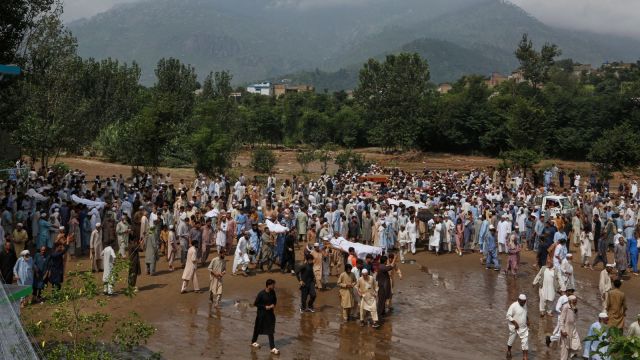Pakistan Floods Kill Over 300 in 48 Hours as Monsoon Rains Bring Unstoppable Destruction

Image via The Indian Express
Date: August 17, 2025 — Northern Pakistan is reeling under one of the worst flood disasters in recent years. In just 48 hours, heavy monsoon rains unleashed flash floods that killed more than 300 people. Entire villages were washed away, leaving behind scenes described by survivors as nothing short of “doomsday.”
Officials fear the toll could rise further as rescue teams continue to search for missing people. With weather departments warning of more rain ahead, the country is facing a deepening humanitarian crisis.
10 Key Points Explained in Detail
1. Sudden Flash Floods Hit Overnight
The disaster struck suddenly. Cloudbursts in northern regions caused rivers to overflow within hours. Houses, bridges, and shops were swept away like paper. Local residents had no time to react, as the floods struck late at night while many were sleeping.
2. Death Toll Crosses 300
By Saturday evening, the official toll reached 307 deaths. Authorities say many people are still trapped under debris. The figure could increase as water levels recede and more bodies are recovered. Families continue to search for loved ones with little hope.
3. Khyber Pakhtunkhwa Worst Affected
The province of Khyber Pakhtunkhwa bore the brunt of the disaster. Buner district alone reported 184 deaths after torrential rain triggered landslides and wall collapses. The hilly terrain made it even harder for rescue operations.
4. Heart-Breaking Stories of Families
In Bajaur district, a man lost his wife and five children when his house collapsed, reportedly after a lightning strike. Similar tragedies are unfolding everywhere. Families have been wiped out, while survivors wander with nothing left.
5. Rescue Operations Under Severe Strain
Pakistan’s army and rescue teams are working round the clock. They have set up medical camps and food stations for displaced families. However, broken roads and collapsed bridges block access to remote areas. Helicopters are being used, but poor weather makes flying dangerous.
6. Helicopter Crash Kills Rescue Crew
In one tragic incident, a rescue helicopter crashed in Khyber Pakhtunkhwa. All five crew members on board were killed. The crash highlighted how dangerous the mission is, as heavy rains and thick clouds reduce visibility.
7. Survivors Call It “Like the End of the World”
Eyewitnesses describe the floods as “like doomsday.” Within minutes, water tore through streets, dragging cars and cattle away. Videos on social media show homes crumbling, roads breaking apart, and people screaming for help. Many said they had never seen such destruction in their lives.
8. More Rain Predicted, Danger Not Over
Pakistan’s meteorological department has warned of more rainfall in coming days. This has left authorities worried that the death toll and destruction may rise even further. Local governments have been asked to remain on high alert and to evacuate vulnerable areas if needed.
9. Why the Floods Are Getting Worse
Experts believe climate change is making Pakistan’s monsoons more violent. Construction near riverbanks, poor drainage systems, and deforestation have also worsened the flooding. Unchecked garbage dumping blocks waterways, forcing rivers to spill into towns and villages.
10. A Growing Humanitarian Crisis
Thousands of families are now homeless. Many are staying in makeshift shelters without clean drinking water, food, or medicine. Relief organizations say that children and the elderly are at high risk of disease. The government has appealed for urgent humanitarian assistance.
The Bigger Picture
The floods of August 2025 are being compared to Pakistan’s 2010 super floods, which killed nearly 2,000 people. However, what makes the current disaster more frightening is the speed and suddenness of the flooding.
In many villages, residents said they received no warning before the waters came. “It felt like the sky opened up and destroyed everything in front of us,” said one survivor.
The damage to roads, crops, and electricity networks will also have long-term effects. Economists warn that food prices could rise sharply, worsening Pakistan’s already fragile economy.
International Reactions
Several international organizations, including the United Nations, are monitoring the situation. Calls for foreign aid are growing as Pakistan struggles to cope with the disaster. Neighboring countries may also step in with relief support.
Climate experts are urging urgent investment in disaster management. They say Pakistan cannot afford to face such deadly floods every year without better infrastructure and early warning systems.